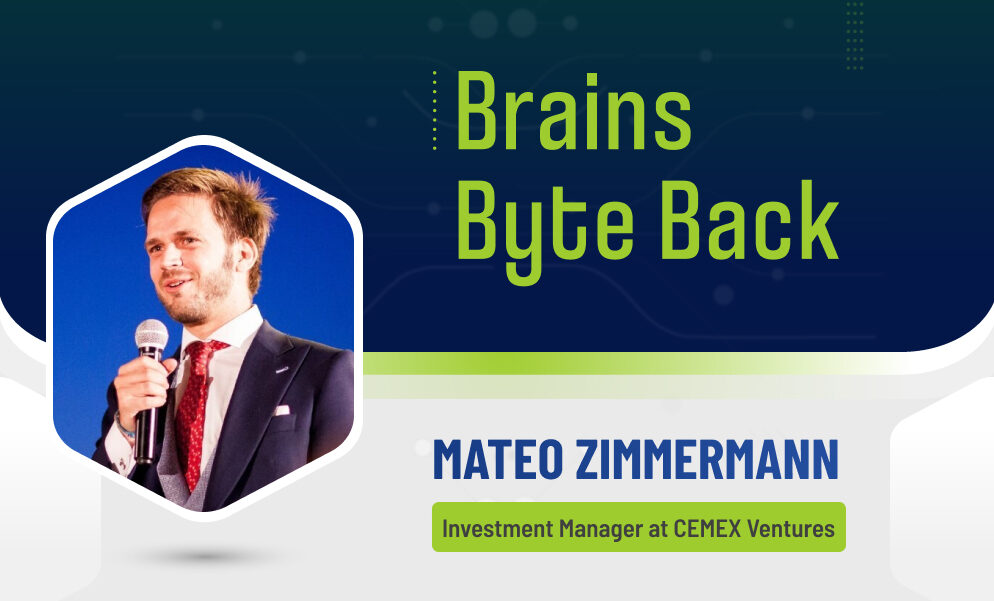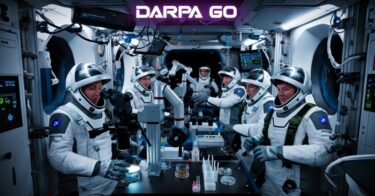In today’s episode of the Brains Byte Back podcast, we speak with Mateo Zimmermann, Investment Manager at CEMEX Ventures, a company that invests in innovative construction startups aiming to foster the construction revolution.
To kick off the show, Zimmermann shares how the company started in 2016 with the intention of partnering with top talent and entrepreneurial spirits to bring innovation to the construction industry, which is lagging behind other industries, thus shrinking the productivity gap.
During the conversation, Zimmermann discusses the challenges faced by young people in finding affordable housing. He raises that in numerous countries, including Spain where he is from, the culture is to buy a home instead of rent. However, even when it comes to renting a place, young people are struggling due to the high costs.
In light of this, Zimmermann advocates that the solution is more housing, but he also notes that the problem doesn’t stop there, as the construction industry contributes to almost 30% of CO2 emissions worldwide, making climate action and sustainability a vital issue for the industry to address.
Zimmermann discusses the various ways that CEMEX is tackling this issue, including focusing on new construction materials with a lower carbon footprint. He draws on an example from one of their portfolio companies which uses plastic waste in concrete to create a sustainable landfill where the waste is buried into the structure of buildings or different elements of the construction.
Moreover, the company also focuses on carbon capture utilization and storage, which involves capturing CO2 emissions and finding ways to process, store, or utilize them.
And finally, Zimmermann speaks about the future of the construction industry, where he talks about how they are testing the use of automation and robotics in construction, which stand to increase productivity and reduce labor costs.
You can listen to the episode below, or on Spotify, Anchor, Apple Podcasts, Breaker, Google Podcasts, Stitcher, Overcast, Listen Notes, PodBean, and Radio Public.
Alternatively, you can find a transcript below:
Mateo Zimmermann: So my name is Mateo Zimmermann, I’m the investment manager at some expenditures and I’m basically responsible for the corporate venture capital investments in startups in the constructions, technologies space. So I kind of my background is actually a before joining symmetry ventures. I was a management consultant work for several years and there for five years to be more specific. And I started working in the industry practice and I worked with construction clients at some point. Got interested in the space so tremendous opportunity to improve how things are done and also kind of some of some interesting challenges and join them in 2017. Join some expenders basically. Yeah, the very beginning, we were setting up the open innovation armor of CEMEX which I’ll explain a second.
Mateo Zimmermann: And we’re doing a little bit of everything just to just to learn or know exactly what we were doing because obviously innovative location. There’s a lot of things that you can do. And little by little, I kind of I focused more and got more experience and to the venture investing and that’s actually what I do right now in, in terms of kind of explaining a little bit, what some expenditures is. So basically we’re the corporate venture capital and open innovation of
Mateo Zimmermann: It open Innovation unit of Sumix which is one of the largest building material manufacturers and in the world and and exactly since 2017. So the same year that I joined, we have been developing relationships between entrepreneurs investors CEMEX and other corporations in order to revolutionize the construction industry as as we know it today. That’s the, the purpose we do this in different ways. Like I said, kind of, we do venture investing,
Mateo Zimmermann: we invest in the startups that have good potential and then have also strategic fit with Simix. We also do a lot of other initiatives like X. We have an acceleration program called Lipab which we officially launch last year and we’re doing the second cohort this year. It’s companies that we will accelerate together with CEMEX to kind of to help them scale to get them, good feedback to get them a pilot project and help them scale. And we also have An Equation arm, We do some specific projects that we launch to the market.
Mateo Zimmermann: Another initiatives, a very big one is actually the largest construction tech competition in the world. We do that together with other corporates and, and in construction. So and that if in the different value chain of of construction and, and yeah, and when we also have a very good initiative, was it naming every year at top 50 context, startups, construction, tech startups, and climate tech startups. In that we’ve met during the year, which is social good kind of. Yeah. Good for the start of social, to help them to help them, get a little bit of of name of there and some recognition. That’s obviously it’s always a good push to help.
Samuel Brake Guia: Awesome fantastic. Well it sounds like you’re working on some great stuff and it’s really nice to have you here today. Mateo. I know you mentioned that you joined the company in 2017 and a lot it sounds like has changed since then but I’d really love to know like when and how did some extensions first start?
Mateo Zimmermann: So, I mean it started a little bit earlier, I mean, 2016, probably what’s the idea? And and the idea was like, in other open. Innovation efforts from other corporates. It’s how can we? I mean, there’s a, there’s a different purposes, right? But first it, how can we help our industry? Right? So we we know that our industry. The construction industry is lagging behind other industries. There’s a famous or so called productivity gap in our industry. That means that our industry has developed and there was proactivity slower than others. Actually in the last century is the probability has been stable and construction whereas in other industries like automotive for example is has been, you know, a very good proactivity increase and so that was the first reason. Second is, obviously the pace of innovation is always changing and it’s it becoming more and more it’s becoming faster, right? So we want to also
Mateo Zimmermann: Part of that. And obviously, for that you, There is the that saying that says that, well, I mean, there is so many people with within the company, right? And there’s so many more people outside of the company. So probably innovation in terms of statistic will come from outside more than from the inside, right? So we wanted to partner with those two kind of smart and top minds and and entrepreneurial spirits to to partner with them to bring innovation because actually you bring both the best of both worlds, right? Kind of the corporate that has a customers as pilots has resources which startups that are actually struggling to kind of with a go to market strategy. Getting some customers pilots and and also come from feedback, right? So there’s a very also very know how intensive industry where you need good advice from people from the industry to get there. So so that was kind of the, the initial idea.
Mateo Zimmermann: and obviously, there’s also A factor of how can we capture most of that innovation. Also but also in terms of changing the culture of the our business, to be more, innovation driven. And actually it’s interesting that now innovation is one of the values of CEMEX as part of our, let’s say our our
Mateo Zimmermann: Yeah. Our our name part of our logo is kind of includes innovation because it has to be something that you do every day. It’s not something that just for us some expenses or R&D departments, it must do it. Something that everyone in the in the organization and the company has to has to push, right? Because it’s it’s difficult but it’s something that is worth it. So so there was a the idea we set up some adventures then in 2017 we say that initially at the very beginning, we started pretty quickly with investing after basically a few months of research. So trying to understand the industry talking to different stakeholders making connections. Understanding what the Mega trends are in construction.
Mateo Zimmermann: What are the pain points where can we support? And and after that Actually we developed our, what we call our focus areas and which basically we’ve categorized them into four, which is basically the first one is green construction. So that’s everything that is around decarbonizing our industry, but also kind of thinking about civility and construction. It’s about water consumption and conservation. It’s energy use, it’s sustainable materials. For example. the next one is a supply chain so how can we when we’re designing with specific materials, How can we improve and increase kind of the productivity from that from that point to how materials are how you estimate materials, how you procure the materials, how you get them delivered to the site when you’re building how to
Mateo Zimmermann: Handle those materials on the site more efficiently. the third category is enhanced productivity, which is really kind of that addressing that productivity gap that I was, I was mentioning So, it really how to increase the communication, coordination transparency between stakeholders and the design and execution phase of projects, because basically in those two phases of design and execution, there’s a lot of players involved. So there is a lot of friction between players and misalignment of interests or just miscommunication, or in the process. So how can we do that more efficiently?
Mateo Zimmermann: That was the topic. So there we look at things like for like a project control monitoring to things like health and safety and as as topics, and the last one is, is what we call feature of construction is, now that means actually everything or new methodologies of construction that change radically change the way we will build today. These are things, like, for example, a 3D printing and construction. It’s industrialized or modular construction. It’s robotics or advanced materials, right? So that’s kind of how we say, kind of how we think about this where we want to focus our efforts and after that we set up different things. Obviously the acceleration program as I mentioned before to be, also closer to bring some explosion to innovation as well. And also the startups to give them opportunities to pilot. And we, we decided to do.
Mateo Zimmermann: That the very beginning. So we wanted first to change a little bit, the culture of the business, And bring innovation closer to the business. And when we decided that the company would be ready, then do the pilots and do the acceleration program. So we did that on purpose to start with earlier. So we intentionally started a little bit outside of the business and a little by little obviously, once there is that innovation culture and momentum to try to bring and connect innovation with our business.
Samuel Brake Guia: Fantastic. Well, I had no idea about that project productivity like that, you mentioned. So that’s completely new to me and that really like, has a blown my mind. And that’s also one of the reasons I love the startup space because it is such a place for innovation and just pushing new ideas and tackling these kind of issues. So I think that’s really awesome and I want to know before we get into the details, I think it would be useful to go over some of the basics. So with this in mind, what is ESG impact and how is it related to offsite construction?
Mateo Zimmermann: Still it’s it’s a good question. I mean ESG and construction is A is a big topic obviously like in other other industries as well, especially I think there’s a in construction there’s a big component in terms of environmental and social especially
Mateo Zimmermann: And I’ll explain that in in a second but it relates actually very tightly with, with construction. And how can we also with innovation but kind of as an industry help with the environment and social? Right. So so I just kind of to give you a few examples of where the problem is and why ESG is really is relevant for construction and kind of in terms of estimations by 2020 and 2015, story and additional 2.4 billion people will be expected to to be looking for a place to live. That’s basically for a trend of of rapid or organization for example and the growth of population. So that number is the equivalent of the new greater London population, every three months for the next 35 years, right? So it’s that’s a big problem. On the other hand we need
Mateo Zimmermann: To ensure that we live in clean livable cities as at the same time. So it’s not just a rapid growth for at every cost, right? So and actually, according to the European commissions, buildings are responsible for 40% of the European Union’s energy consumption and 36% of greenhouse gas emissions, right? So so it’s also we think we need to think about the social component of we need houses and we live near affordable houses but we also need to be kind of thinking about sustainability and how this will impact our climate right.
Mateo Zimmermann: So, and the other thing in terms of also environment, which is very important topic in construction is waste, right? A construction demolition and excavation waste generates one third of world’s overall waste, right? So then that that’s that’s a very big number. So I think that’s that’s part of why this way, this is important and why we need to find solutions and innovation and technologies that will help us get there. One of the solution that you mentioned in terms of site construction and is particularly interesting because it tackles both of these issues, right? So that’s one of why we think this is. There’s part of our, Our focus is often construction or modular construction, and
Mateo Zimmermann: And that is actually a market that is predicted to grow from 76 billion US dollars and in 2021 to 115 billion in 2028, right? And why is that for different reasons in terms of again environmental and social, right? So for first reason, is actually eliminates waste. So just to give you a rough numbers but typically as more 25,000 square foot office produces about 100,000 pounds of waste, right? So actually with modular construction you can reduce that waste by 98%, right? And why. Because actually you in A in A in a modular construction project
Mateo Zimmermann: You precisely know the amount of material that you need from the design. You can order accordingly, all this kind of very details in the, in the, in the design but also because you can reuse the waste material more efficiently. Kind of and it’s wanted to get a step back maybe and explain what we, what we mean by modular construction. Right. But basically, right now the process how it works and construction is we build prototypes. Basically, you have for every for every site. You have a specific. You have any architect designer planner engineer, that’s just kind of a customized building for every location. Every project is completely new, right? And and all this stakeholders, there will be involved in that project actually.
Mateo Zimmermann: Working together, probably for the first time or the second time together, right? So so there’s a lot of things that can go wrong, right? If if we think about buildings more, like products or systems, where, and you think about this more like like a car, for example, so you actually have spent more time on the design a and build it in a factory. So you some of these elements, you build them in a factory. So outside of the site and with much better planning, much better accuracy of machinery and so on
Mateo Zimmermann: You can manufacture them in a factory and then deliver them to the site and assemble them. Right. So, so that’s what we mean my modular construction. So it’s basically building in factories, at least part of the components of, of a building, right? So, and, and in terms of benefits, there’s also kind of big benefits in terms of operational energy efficiency of those buildings. If, as I said, these buildings are products instead of building stuff through the prototypes and you can think of it as a system, you, you’re studying how the different modules, the systems and elements work together as a whole. And, and that way, you can improve the performance of building. So, again, bringing that to the example, of course,
Mateo Zimmermann: If, if you were to do like a prototype car, kind of what one, what kind of one of car that is being manufactured with the same circumstances that I said before, kind of a new new elements, new products new, like, for example, new parts. Every time there will be a lot of issues, right? If you do it kind of a repeatable with kind of a more strategic relationships and commercial agreements with suppliers and stakeholders involved, you can have a better performance, right? So what that’s where we’re looking at for and when in terms of energy efficiency plus, you can also design better and and do some improvements to the design for example in the heating systems and or even sads doing some also some continuous improvement to to improve how how that product that building as a product.
Mateo Zimmermann: on the other side, in terms of benefits, in terms of environment, these modular designs are also designed for disassembly. So that’s the, there is the common description which is called the design for manufacture and assembly. So there’s basically what describes your designing specifically thinking, how, how you’re gonna manufacture it and how you’re gonna assemble it. But there is a kind of an increasing concept of design for manufacturer. Assembly and disassembly, right? Instead of demolition. So that will also increase or decrease at least the debris in construction and the waste generate
Mateo Zimmermann: And in terms of, kind of the social benefits of this, and I mentioned it before which the biggest is affordable home, right? So for example, in the UK, which is a good example, because there is a big gap of housing and the need for housing is very big. So actually it’s estimated to be 1 million homes needed in the UK. So that means well I right now kind of in the UK I think like 160,000 homes are built per year.
Mateo Zimmermann: And we estimate that we need 300,000 instead, right? So there’s a massive gap there that we need to cover, right? And we need, that means we need fast homes, but also kind of sustainable, right? So modular construction is, is perfect for that because, actually, the main benefit of modular construction is that you can build faster because you’re actually, instead of building sequentially instead of building first preparing kind of doing groundworks. And then building, basically you’re doing this at the same time you’re while you’re doing the groundworks and earth movements, you’re actually building in the factory, right? So that may makes the construction shorter. And on the other kind of, the also social benefit of of the construction.
Mateo Zimmermann: Is that it’s actually it provides a safer and more human centric and friendly work environment for for the workforce, right? And and there’s a massive problem in construction as well as in other sectors with skilled work. Right there is a massive shortage of skilled workforce and and that’s why also we need to provide an attractive or my environment for workers, right? and that also allow us to To attract a more, a more diverse workforce, right? For example, there’s a massive, there’s a problem with attracting women in construction. So, and, and I think factory work could be, could be more attractive for a lot of different people and which could attract and, and mitigate the problem that we have with the workforce,
Samuel Brake Guia: Yeah. I mean you have covered so much there which is just blown my mind. And I have to say that I can completely understand what you’re talking about with regards to this like deficit and housing like a, we spoke briefly before the podcast. I no longer live in the UK, but one of the things that I see when I’m looking in is definitely, there’s so many people are suffering with this issue. Certainly the city that I’m from Bristol. It’s a very popular city and that is something that I see all the time online about how How hard it is to a find a place or b, even be somewhere without them, raising the rent so much because there’s so much competition and it really makes it insufferable and I honestly don’t think that I could ever move back to my home city because the it’s too fierce a competition.
Mateo Zimmermann: Yeah.
Samuel Brake Guia: There’s too much, too many people wanting to live in a space where there’s two little housing. So There’s yeah.
Mateo Zimmermann: Yeah. And there’s the there’s that kind of a massive problem with especially with young people that and,…
Samuel Brake Guia: Yeah.
Mateo Zimmermann: you know, the increase of kind of, the kind of the costs live costs and there’s a, it’s a massive problem. So actually, young people can afford to buy homes anymore,…
Samuel Brake Guia: Hmm.
Mateo Zimmermann: so they have to rent. But so that’s kind of that creates also kind of someone uncertainty for the, for the future, right? For my work. Where I come from? Where I come from Spain, not a kind of it was we’re used to buying homes, kind of like there is not, not kind of a culture of renting homes. It’s normally it was buying process, right? And and kind of like yellow young. People are kind of dependent on their parents and, and can’t afford to, to even kind of renting. Yes. But, you know, The economy. It’s delaying actually when they leave home to kind of, to pursue their or their own careers on their own lives, right? So it’s a,…
Samuel Brake Guia: Mm-hmm.
Mateo Zimmermann: it’s a massive problem and I’m not kind of in the whole packet of homes, but I know young people are suffering a lot as well.
Samuel Brake Guia: Yeah, I’ve definitely seen that and I’ve seen that the rates of young people staying at home for longer has gone up and also, you know, it may be wasn’t so much of an issue when I left in 2000 and 2016. I think it was, I left the UK then, but that’s one of the reasons why I have kind of enjoyed life here in Medellin. So much is because it is a space for digital nomads and people can come here and you can avoid this in your home country but I don’t think it necessary solves the problem. It just shifts the problem because one thing that I have noticed here is that a lot of people are saying that the the rent have gone up here. Because all these foreigners are now coming in and taking up the homes. So it’s like, it doesn’t, it doesn’t solve the issue on a global scale. It just moves it to another country.
Mateo Zimmermann: Yeah.
Samuel Brake Guia: So definitely it seems like the only solution is more housing. There is no way around this. I see other than that.
Mateo Zimmermann: Yeah, I agree.
Samuel Brake Guia: Now, I wanted to ask you so many questions and you know what you have covered so much already that I feel that I would just be forcing you to repeat yourself because you have just done such a fantastic drop of articulating. Everything that I was hoping to cover really, and I really appreciate that Mateo. You’ve like I said, I know and it’s like third time saying it, but blowing my mind. Honestly, this is such an insightful conversation and I know that you folks are working on so much, like, what is next on the horizon for some expenses?
Mateo Zimmermann: I mean, we a lot of thing, different things, obviously right, from the from the things that I mentioned, there is a lot of if you go deeper into that, there’s a lot of different topics that are interesting and I think,
Mateo Zimmermann: And the, the first one is obviously carbon or climate action is is a big topic for us. It’s not only for our company for CEMEX, but also for us as a kind of as a value as a as a mission and we have to help there. There is a massive, massive problem. As I said, kind of almost 30% of CO2 missions come from construction and building operations. So we need to address that so that’s taking obviously a lot of our time and a lot of our thinking is is that right? So so and that’s probably also kind of the biggest mega trend that we’re seeing kind of specially kind of how it has increased in relevance, in the last years has been has been amazing. So um and we see that other people coming to the to the industry getting interested in into that other investors are asking us and looking for solutions.
Mateo Zimmermann: In that space. So probably sustainability in climate action is the biggest one but there’s a lot of other things that we do. So for example, and we focus a lot on new construction materials that have a lower CO2 footprint. I’m focusing now on again, all still in in reducing carbon emissions, right? Because it’s a big topic but there’s different ways to tackle that, right? So and there’s kind of that’s how new technologies and other practices can help us. And for example, that kind of on those new construction materials, we have a portfolio company called Art Light, which is actually introducing plastics, so, plastic waste into concrete. So, basically, that’s a way of like landfilling, but can have a sustainable landfill where you actually burying that into the structure of buildings or into the concrete and to different elements of company.
Mateo Zimmermann: In terms of decarbonization, there’s a famous kind of technologies called carbon capture utilization and storage. That actually means that a lot of efforts in our industry are to decrease CO2, but there is so much you can do. And at some point it’s not just changing materials and so on, but it’s actually how can you capture that this CO2 that is emitted? How can you process that or How can you store it? But also count. How can you utilize that, right? So there’s a few examples there. We have a company, we have working with a company called Carbon Clean, which is actually carbon capture technology based on, I mean system. So it makes basically reacts with the CO2 and captures this CO2 and to use it in later. In terms of the usage, there’s a company that we have invested in called carbon cycling.
Mateo Zimmermann: Which is basically activating waste and variable feedstock with CO2 in a reactor. So basically, those feedstock would be kind of waste from other industries like slack, flyers or even a construction, the Malaysian waste and it converted into what we call. Supplementary cement tissues material. That means that is actually a material that can replace cement as a submit a meter of CO2, right? So you’re basically lowering the content of cement in the concrete so you can you can build with a lower CO2 footprit. In terms of kind of the other things. We’re also looking at eternity fuels, so how to create or developed kind of a great clean energy. Like, for example, hydrogen as a as a clean energy source and we invest in a company called highrock working them on some projects for example, and UK
Mateo Zimmermann: I mean in the US as well and secularity as I mentioned before, also a big topic for us. So there’s different solutions from Internet of things and sensors management platforms and also kind of new technologies to identify linked and process waste. Two Examples. There there’s a company called Soy Connect, which is basically using the excavation waste from one side. Could use that. Let that sand that aggregates as an input for other things. So, instead of actually treating is as a waste, it’s actually treated as an input for someone else, right? So it’s actually shortens the way the time of of waste disposal and it’s it’s much more efficient.
Mateo Zimmermann: In terms of also, using waste for other things. We’re looking at technologies to transform waste into energy. Right? So for example, there’s a company called Ways to Energy which is an end-to-end solution to transform transform, solid waste. Like, for example, waste from the city. So it’s municipal waste convert that into clean and a versatile center synthesis gas, which is, which is a basically, what that can provide energy, right? It’s through augustification process.
Mateo Zimmermann: Then kind of more things a little bit more connected to software and we’re looking at what the cons sustainable product databases. So if you look at it from the emissions that I mentioned before, actually, 20% of emissions, CO2 emissions, come from bad decisions in the design phase, probably a lot of them because you, you’re unable to take the right decisions because you don’t have enough data to make those right decisions, right? So these platform basically help you to select and specify sustainable materials. So that means having the right information at the right time to compare materials and decide which are the ones that have a lower, CO2 impact, for example,
Mateo Zimmermann: And that is it’s it’s difficult, right? Because you have so many variables when deciding on that kind of you have to look at aesthetics at. How easy is it to install the costs water usage, CO2 footprint and kind of health information and so on. Right so it’s it’s a it’s difficult if you don’t have enough information it’s difficult to make the right choice.
Mateo Zimmermann: And actually very connected to that. There’s another very interesting technology that is basically life cycle assessment technologies. So it’s at it again at the design stage. Once you have those materials selected, How can you compare them? And for example, if you choose one, facet or another facet and which one could be better in terms of sustainability but much more expensive, the others cheaper but less it’s it’s not that good in terms of sustainability but you can compare all that also with costs, right? So you can actually take the best decisions with costs and pay back period information. So you can basically say if you choose the
Mateo Zimmermann: one facade that is more expensive but actually it will return in two years right? Because you will have lower operational costs and operating the building. So you can have actually do that decision based on on real facts and instead of just intuition right? So so it it helps I’m not just looking at the in in our industry we make a difference between embodied carbon, which is basically the carbon that is emitted during the construction of the all the building.
Mateo Zimmermann: And the operational carbon, which is the carbon that is emitted during the lifetime of the building, right? So it can energy, especially or kind of insulation and so on. So, basically, normally the decisions are based on embodied carbon. So how much carbon is, is emitted during the construction? Because you can measure that, but you can you need also to to see, okay, what, what will be the impact of those decisions on the on the life cycle of the building, right? So, so you need to have all that information to me again, to make the best decision possible, right? And, and that’s interesting, and just that just to finalize on on things that we’re working on it’s and we have a collaboration with 3D printing, kind of construction company.
Mateo Zimmermann: Called cobot, which is manufacturers the most advanced robotics in construction for printing. So and you can print out actually all the walls of our building with concrete and through a robot. So that’s what’s through a country system. So actually it’s a like, three dimension robot that will move in three axis to yeah, to build a whole kind of like a whole single family home.
Samuel Brake Guia: That’s amazing. I’ve seen those videos before and that’s really incredible. I have to say Mateo. It’s been such an inspiring conversation. It’s great to know that there are solutions for so many of the big issues we face as a society globally. And yeah, I just want to thank you once again, for joining me today. It’s been a real pleasure.
Mateo Zimmermann: Yeah, thank you Samuel. Thank you. Thank you very much for the for, for the invitation and and for having us and the share a little bit of what we do. And I can only challenges that our industry is facing, but also how we can solve that with innovation.
Disclosure: This episode includes a client of an Espacio portfolio company












